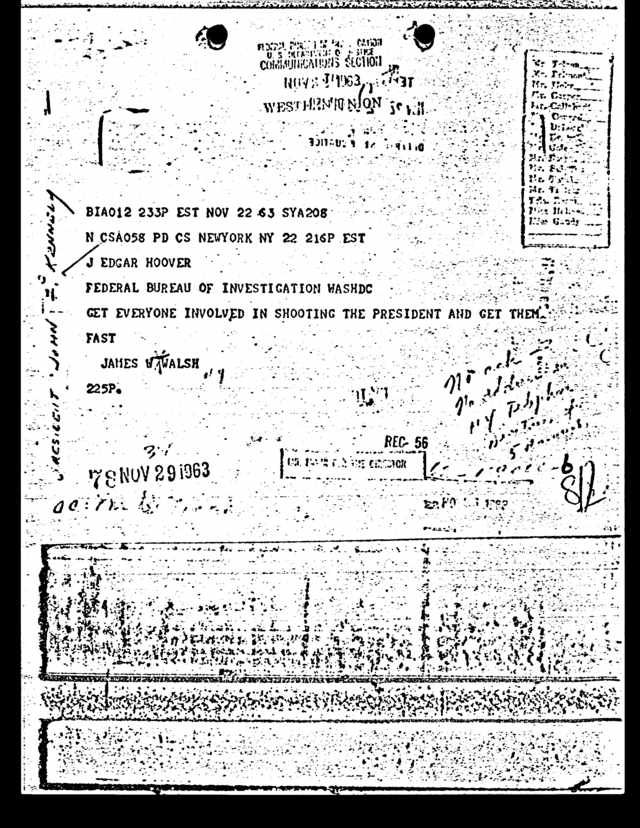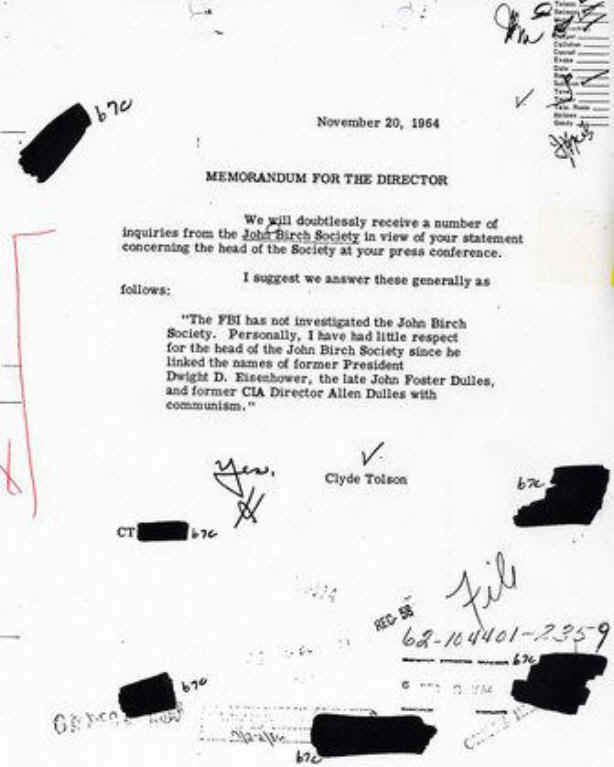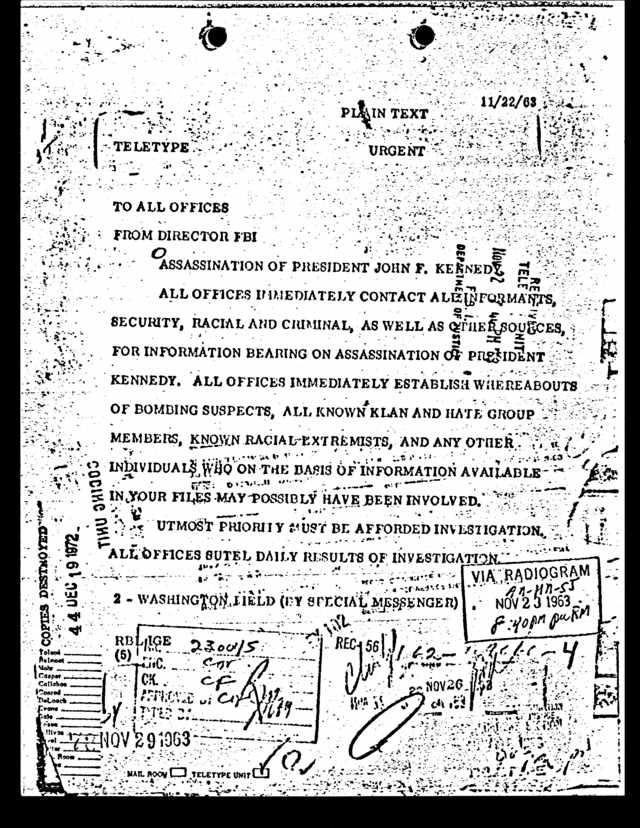By Sunday night November 24, 1963 the Biggest Suspect was the FBI ! ! !
SEE>>> http://whokilledjfk.net/Robert%20Oswald.htm
(Found under the Characters Button)

(With two exceptions, they blamed
the right.)
Editorials
The New Republic
"Another
Beginning" ( 7 December 1963)
"How
Could It Happen?" ( 7 December 1963)
The Nation
"John
F. Kennedy" (14 December 1963)
"The
Climate of Violence" (14 December 1963)
"The
American Condition" (21 December 1963)
"The
Warren Commission" (28 December 1963)
"Task
of the Warren Commission" (27 January 1964)
"Then
How About Koch?" (2 March 1964)
"The
Dallas Rejoinder" (25 May 1964)
Commentary
"The
Warren Commission: An Editorial" ( January 1964)
Articles
The New Republic
"When
Castro Heard the News" (Jean Daniel, 7 December 1963)
"Unofficial
Envoy: An Historic Report from Two Capitals" (Jean Daniel, 14 December
1963)
"Further
Clarification: Interviews with Kennedy and Castro" (Jean Daniel, 21
December 1963)
"Seeds
of Doubt: Some Questions About the Assassination" (Jack Minnis and
Staughton Lynd, 21 December 1963)
"Seeds
of Doubt" (Annotated version)
The Minority of One
"Who
Killed Whom and Why?" (M.S. Arnoni, January 1964)
"The
Death of a President" (Eric Norden, January 1964)
"16
Questions On The Assassination" (Bertrand Russell, September 1964)
New Times
"The
Dallas Investigation" (11 December 1963)
"Assassin
or Fall Guy?" (23 September 1964)
National Guardian
"Oswald
Innocent? A Lawyer's Brief" (Mark Lane, December 1963)
The Nation
"A
Most Unstuffy Man" (H. Stuart Hughes, 14 December 1963)
"The
TV Image" (Paul T. David, 14 December 1963)
"The
Roots of the Agony" (Reece McGee, 21 December 1963)
"'Manchurian
Candidate' in Dallas" (Richard Condon, 28 December 1963)
"Oswald
and the FBI" (Harold Feldman, 27 January 1964)
"Tussle
in Texas" (Saul Friedman, 3 February 1964)
Commentary
"The
Oswald Affair" (Leo Sauvage, March 1964)
The New Leader
"Thomas
Buchanan, Detective" (Leo Sauvage, 28 September 1964)
"In
Defense Of A Theory" (Thomas G. Buchanan, 9 November 1964)
"As
I Was Saying" (Leo Sauvage, 9 November 1964)
Reactions of the Left
The Left reacted as strongly as the Right did. Without
benefit of formal investigation, they securely and self-confidently blamed
right-wing Americans for the assassination. How did they know? They didn't, pure
and simple, because they couldn't have—it was too early. No official evidence
or findings had been released, and the
Editorials We present early editorials from The
New Republic, The Nation, and Commentary. The two from The
New Republic are not polemic. The first, "Another
Beginning," discusses with hope the transition to Lyndon Johnson's
administration. "How
Could It Happen?" takes an incredulous look at how Jack Ruby was able
to enter the
Articles The three articles by Jean Daniel in The
New Republic make some of the earliest reactions by individuals of the Left
that we have. "When
Castro Heard the News" deals with the reactions of Fidel Castro to the
assassination, which Daniel could observe directly because he was interviewing
Castro as the news came in. "Unofficial
Envoy: An Historic Report from Two Capitals" and "Further
Clarification: Interviews with Kennedy and Castro" deal mostly with the
Cuban missiles, but are included here because of their intense interest and
their tight relation to the first article. Together, these articles make
riveting reading.
Two days after
M.S.
Arnoni was the publisher of the leftist monthly entitled The Minority of
One--Independent Monthly For An American Alternative--Dedicated To The
Eradication Of All Restrictions Of Thought. During the early sixties, it
published many articles of consequence on the JFK assassination that helped
promote the idea of conspiracy. The article "Who
Killed Whom And Why?" was written 1 December 1963 and published in the
January 1964 issue. In it, Arnoni offers the idea of Kennedy-the-warrior, even
to the point of his administration's planning to stage a fake international
incident that would provide an excuse to "take back"
Eric Norden was a leftist freelance writer. His long article "The
Death Of A President" appeared in the same issue of The Minority of
One as Arnoni's did, which makes it another very early reaction by the Left.
Norden review all the difficulties with the official explanation, which was
still less than one month old as he was writing, and concludes that Kennedy was
most likely killed by a rightist plot initiated at very high levels, which
involved Oswald and Ruby but made them both fall guys. Also, the Dallas Police
Department must have been deeply involved in the plot. Further, the plot was set
up so as to make it appear the work of Leftists, for which Norden takes a
certain amount of umbrage. He ends by noting that signs of a backlash against
Leftists were already beginning to appear in the U.S.
One prescient aspect of Norden's article is his dire warning
about how much the Warren Commission (which was still called the "special
Presidential commission") would be at the mercy of the investigating
agencies FBI, CIA, and SS for their information. They would hardly criticize
themselves or each other. This prediction turned out to be right on the money.
As you read Norden's highly detailed article, you may find it interesting to see
what fraction of his "facts" were correct. My reading suggests that he
was right far more often than he was wrong.
Bertrand
Russell was a world-famous socialist in
The
The Soviet press also produced a series of articles in their
weekly New Times, which at its maximum was printed in 53 languages. They
began commenting on the assassination soon after it occurred. These articles
pushed the idea that the assassination was the work of reactionary rightist
elements in the United States, whose goal was to get the U.S. government to
blame the Soviet Union and thereby deepen the Cold War. The two earliest of
these articles that we have been able to find appeared before the Warren Report
did. They are "The
Dallas Investigation," in the New Times of 11 December 1963, and
a review
of Joachim Joesten's "Assassin Or Fall-Guy?", the issue of 23
September 1964, just before the Warren Report was released.
Some writers, particularly Armand Moss in his Disinformation,
Misinformation, and the "Conspiracy" to Kill JFK Exposed, have
proposed that the Soviet Union was using this propaganda to try to take
advantage of
Mark
Lane was one of the first Americans to raise his voice against the
"official" version of the assassination as he saw it developing. As
early as December 19, 1963 (less than one month after the assassination), he
published a five-page lawyer's brief in
The liberal The Nation also weighed in, with a series
of six articles over two months. These articles, which collectively declined to
invoke a conspiracy of the Right, drew the ire of legions of leftists and began
the split down the middle that is discussed further under Reactions
to the Warren Report. The idea in many minds was that you weren't a good
leftist unless you didn't see the obvious rightist plot and the
The first article, "A
Most Unstuffy Man," by H. Stuart Hughes, was a brief paean to the
President who died at the top of his form. "The
TV Image," by Paul T. David, is a one-pager that marvels at the power
of television for those four days. It also speculates that the uninterrupted
coverage gave a great boost to Lyndon Johnson and the Democratic party. Reece
McGee's "The
Roots of the Agony" recounts this professor of sociology's observations
of the unique social mores of
Leo
Sauvage was chief
After Thomas
Buchanan published his early book Who Killed Kennedy?, Sauvage
aligned himself strongly against it. He did battle with Buchanan in a three-part
series in The New Leader ("Thomas
Buchanan, Detective," by Sauvage; "In
Defense Of A Theory," by Buchanan; "As
I Was Saying," by Sauvage) in its issues of 28 September and 9 November
1964. Because these articles draw on Buchanan's book that was published in May
1964, well before before the Warren Report was issued the following September,
we include them here as pre-WCR reactions. For more information on Sauvage, see
his biography.
Thomas Buchanan was an American expatriate living in
Coupled with>>> http://whokilledjfk.net/Robert%20Oswald.htm
And, This one

Pre-WCR Reactions to the Assassination
By "Pre-WCR Reactions," we mean reactions to the
assassination before the Warren Commission issued its report. This covers the
ten months from 22 November 1963 to September 27, 1964, which we might call
"The First Year." While this period is often neglected when discussing
the history of research into the JFK assassination, it is disproportionately
important for two reasons: (a) the early opinions and positions on both sides of
the question set the tone of those to follow, to an extent that could hardly
have been predicted; and (b) this period offers a unique look into the groups of
people who formed strong opinions before all the facts were released, i.e., in
advance of official data that could justify those opinions. In other words,
we can use events of this early period to see who was reacting in knee-jerk
fashion, and maybe even why they were reacting so. There may be no better way to
reveal the human foibles of JFK researchers than to study what happened during
The First Year.
We have divided the literature from The First Year into
reactions of the Center, the Right, and the Left. The list below shows clearly
that these reactions were dominated by the Left (as were the reactions after the
Warren Report was issued). In fact, a quick count of the items on the list (as
of December 2000) gives 2 from the Center, 3 from the Right, but a whopping 31
from the Left. Why was the Left so vociferous? As far as I know, there is no
consensus on this question. Some people have proposed that the Left, having just
survived the brutal attacks of Senator Joseph McCarthy and other ultra-Rightists
in the Senate and the House, reacted defensively to ensure that they would not
be accused of killing the President, too. Another possibility is that
left-leaning observers tend to see conspiracies more than right-leaners do. A
third possibility is that after eight years of Eisenhower and Nixon, the Left
was so happy to have "their" Democrat in the White House that they
overreacted out of general sensitivity when he was killed. Whatever the
explanation, it is clear that the Left made far more noise about the
assassination than the Right did, and continue to do so to this day.
As you read these materials, you will see the Center (Daniel
Patrick Moynihan in particular) warning about the rise of conspiratorial
thought. You will then see exactly that happening, as the Myth of Conspiracy
appeared on the Left immediately after the assassination. You will then begin to
understand why The First Year was such an important period.
The rest of this page first lists the full suite of materials
provided for The First Year, as divided in to reactions of Center, Right, and
Left. It then gives links to the three separate sections, where the individual
articles and their authors are introduced in more detail.
Overall list of materials in "Pre-WCR Reactions to the
Assassination"
A Poem
"November
26, 1963" (Wendell Berry, The Nation, 21 December 1963)
Reactions
of the Center
Editorial
from The New Yorker (7 December 1963)
"The
Paranoid Style," (Daniel Patrick Moynihan in The Washington Post,
reprinted in JFK: The Book of the Screenplay)
Reactions
of the Right
Revilo
P. Oliver, of the University of Illinois
Marxmanship
in Dallas I (February 1964)
Marxmanship
in Dallas II (March 1964)
Assassination
and Its Aftermath, by Congressman Martin Dies (March 1964)
The
Far Left (Billy James Hargis, 1964)
What
Was Back of Kennedy's Murder? (Evangelist John R. Rice, 1964, shortly after
the assassination)
Reactions
of the Left
Editorials
The New Republic
"Another
Beginning" ( 7 December 1963)
"How
Could It Happen?" ( 7 December 1963)
The Nation
"John
F. Kennedy" (14 December 1963)
"The
Climate of Violence" (14 December 1963)
"The
American Condition" (21 December 1963)
"The
Warren Commission" (28 December 1963)
"Task
of the Warren Commission" (20 January 1964)
"Then
How About Koch?" (2 March 1964)
"The
Dallas Rejoinder" (25 May 1964)
Commentary
"The
Warren Commission: An Editorial" ( January 1964)
Articles
The New Republic
"When
Castro Heard the News" (Jean Daniel, 7 December 1963)
"Unofficial
Envoy: An Historic Report from Two Capitals" (Jean Daniel, 14 December
1963)
"Further
Clarification: Interviews with Kennedy and Castro" (Jean Daniel, 21
December 1963)
"Seeds
of Doubt: Some Questions About the Assassination" (Jack Minnis and
Staughton Lynd, 21 December 1963)
"Seeds
of Doubt" (Annotated version)
The Minority of One
"Who
Killed Whom and Why?" (M.S. Arnoni, January 1964)
"The
Death of a President" (Eric Norden, January 1964)
"16
Questions On The Assassination" (Bertrand Russell, September 1964)
New Times
"The
Dallas Investigation" (11 December 1963)
"Assassin
or Fall Guy?" (23 September 1964)
National Guardian
"Oswald
Innocent? A Lawyer's Brief" (Mark Lane, December 1963)
The Nation
"A
Most Unstuffy Man" (H. Stuart Hughes, 14 December 1963)
"The
TV Image" (Paul T. David, 14 December 1963)
"The
Roots of the Agony" (Reece McGee, 21 December 1963)
"'Manchurian
Candidate' in Dallas" (Richard Condon, 28 December 1963)
"Oswald
and the FBI" (Harold Feldman, 27 January 1964)
"Tussle
in Texas" (Saul Friedman, 3 February 1964)
Commentary
"The
Oswald Affair" (Leo Sauvage, March 1964)
The New Leader
"Thomas
Buchanan, Detective" (Leo Sauvage, 28 September 1964)
"In
Defense Of A Theory" (Thomas G. Buchanan, 9 November 1964)
"As
I Was Saying" (Leo Sauvage, 9 November 1964)
EVEN THE FBI ! ! !

Contact Information tomnln@cox.net
